The speed limit along Highway 1 in Cambria is 55mph, but some people feel that it needs to be lowered.
“I am always looking and I’m always scanning the side of the road. They come out quick and you don’t have time to react,” said Christine Siebuhr, Cambria resident.
Christine Siebuhr has lived in Cambria for the past 25 years and travels Highway 1 daily.
“A lot of people brace themselves for what we see on the side of the road. There are a lot of animals that get killed,” said Siebuhr.
She says she wants to see the speed lowered along Highway 1 through Cambria for not just the safety of drivers but also animals. “I would hope it would be lowered to 40. I’d be happy with 45,” Siebuhr said. “Unfortunately, we can see up to 5 or more a week. This fawn season has been very sad. There have been multiple fawns killed weekly.”
Siebuhr has spent the past four and a half years trying to make changes to this stretch of road, including recently gathering 600 signatures in a petition.
Her efforts paid off; a $354,000 grant was recently awarded to the San Luis Obispo Council of Governments, or SLOCOG, from Caltrans, which will be used to help the communities of San Simeon and Cambria with a climate resiliency and safety study along Highway 1.
“We will look at speeding, unsafe crossings, and wildlife collisions, while also preparing for flooding and landslides that are linked to climate change,” said John Dinunzio, SLOCOG regional transportation planner.
The study will take place on a 12-mile stretch of Hwy 1 from Hwy 46 to Hearst Castle.
“In the last five years, there have been over 30 collisions along there that have resulted in either severe or fatal injuries, so it is a pretty dangerous stretch of road,” Dinunzio said.
SLOCOG regional transportation planner John Dinunzio says they will be logging and looking at different components to improve the road.
“They will all be analyzed, weighted, and scored. The idea with that is that we can make the best financial choice given the limited resources that we have to find the project that will benefit the community, traveling public, and visitors alike,” Dinunzio said.
Siebuhr says she’s hoping changes are made.
“Hitting a deer with your car can be very dangerous, and having any kind of wildlife in your path can also be dangerous. Not having any time to think whether to go right or left can be very fatal and bad,” Siebuhr said.
Dinunzio says the study is expected to start in February.
For more information on Siebuhr's petition, click here.





